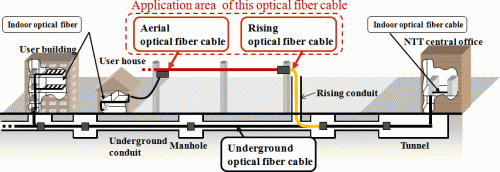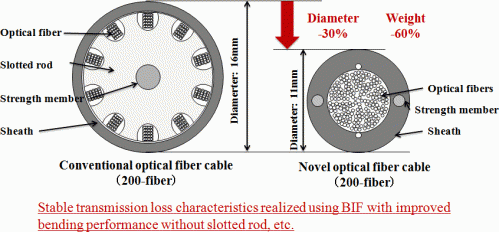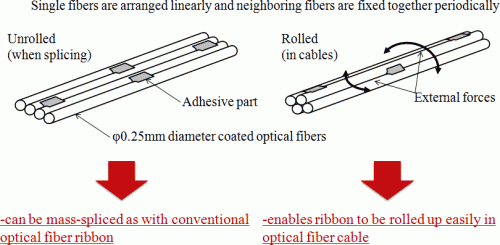Development of world's highest-density optical fiber cable

Nippon Telegraph and Telephone Corporation has developed the world’s highest-density multi-fiber optical fiber cable for outdoor optical fiber networks. NTT Access Network Service Systems Laboratories (NTT Labs) succeeded in increasing to an ultimate fiber density of optical fiber cable by using bending loss insensitive optical fiber (BIF) and novel optical fiber ribbon.
This optical fiber cable will be come into practical use in Nippon Telegraph and Telephone East Corporation (NTT East) and Nippon Telegraph and Telephone West Corporation (NTT West) in late July, 2012. The lighter-weight and smaller-diameter optical fiber cable due to increase in its fiber density will be expected to contribute to improvement of the installation workability and effective use of infrastructure will be expected.
Optical fiber cable is required to have smaller diameter and lighter weight as well as stable transmission loss characteristics and mechanical characteristics. Usually, outdoor optical fiber cable is installed over several hundred meters. Lighter-weight of optical fiber cable enables improving in the workability of installation, e.g. manual installation without towing machines or installation by fewer workers. Also, smaller diameter of optical fiber cable enables the effective use of available space to install optical fiber cable such conduits. To expand the spread of FTTH service, NTT Labs. has been developed the optical fiber cable with smaller diameter, lighter weight and higher density to achieve effective construction of the optical fiber network.

NTT Labs has developed the world’s highest-density optical fiber cable that uses BIF and a novel optical fiber ribbon that we call “rollable optical fiber ribbon”. This cable is composed rollable optical fiber ribbon which standard 0.25mm diameter coated optical fibers are intermittently bonded in a longitudinal direction. By deploying this optical fiber cable to aerial and a part of conduit area as shown in Fig. 1 , it can achieve effective construction of optical fiber network. This cable has 30% smaller diameter and 60% lighter weight than conventional slotted rod type optical fiber cable as shown in Fig. 2.
Optical fiber cables should be designed to allow stable loss characteristics and mechanical characteristics in the presence of external forces as bending, tension and compression. In a conventional optical fiber cable, it is necessary to protect optical fiber from such external forces by slotted rod or buffer layer.
(1) Densely assembling technologies using BIF
The optical fibers should be tightly bundled as much as possible to realize the extremely smaller-diameter and lighter-weight optical fiber cable. However, it has been difficult to suppress the optical loss increase caused by micro bending force in cable when using conventional optical fibers. In this new developed optical fiber cable, stable transmission loss characteristics can be realized by using BIF which has an improved bending performance.
(2) Rollable optical fiber ribbon technologies (Fig.3)
When we construct optical network, mass-splicing of the optical fiber is required for efficient fiber connection. Therefore, optical fiber ribbons are widely used. However, they have less flexibility depending on bending direction, and so they will cause a large fiber strain when these are tightly assembled. This is because the fiber ribbons in the cables will be bent within their plane surfaces. A novel optical fiber ribbon is composed of four single fibers that are arranged linearly and neighboring fibers are fixed together periodically. This structure enables the ribbon to be rolled up easily in optical fiber cable. Therefore, this ribbon can be accommodated very tightly in the cable. Also, this ribbon can be mass-spliced as same as conventional optical fiber ribbon.

To further expand the spread of broad-band services, we will continue investigating the optical fiber cable structure according to other application areas of optical fiber networks.
Provided by NTT

















